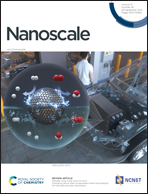Velocity control of protein translocation through a nanopore by tuning the fraction of benzenoid residues†
Abstract
Protein sequencing is essential to unveil the mechanism of cellular processes that govern the function of living organisms, and which play a crucial role in the field of drug design and molecular diagnostics. Nanopores have been proved to be effective tools in single molecule sensing, but the fast translocation speed of a peptide through a nanopore is one of the major obstacles that hinders the development of nanopore-based protein sequencing. In this work, by using molecular dynamics simulations (MDS) it is found that the peptide containing more hydrophobic residues permeates slower through a molybdenum disulfide nanopore, which originates from the strong interaction between the membrane surface and the hydrophobic residues. The binding affinity is remarkable especially for benzenoid residues as they contain a hydrophobic aromatic ring that is composed of relatively non-polar C–C and C–H bonds. By tuning the fraction of benzenoid residues of the peptide, the velocity of the protein translocation through the nanopore is well controlled. The peptide with all the hydrophobic residues being benzenoid residues is found to translocate through the nanopore almost ten times slower than the one without any benzenoid residues, which is beneficial for gathering adequate information for precise amino acid identification.



 Please wait while we load your content...
Please wait while we load your content...